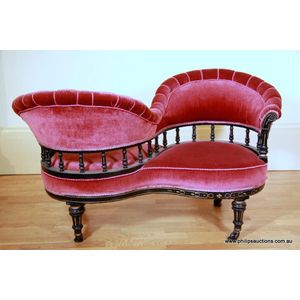Victorian Ebonised Tete à Tete Love Seat
You must be a subscriber, and be logged in to view price and dealer details.
Subscribe Now to view actual auction price for this item
When you subscribe, you have the option of setting the currency in which to display prices to $Au, $US, $NZ or Stg.
- Spindles - Short turned pieces, used as stretchers or back supports mainly in cottage chairs, couches and day beds. Turned shelf supports and the railings used in the backs and arms of day beds during the late 19th century are also referred to as spindles. Until the coming of the industrial age, spindles, like all turned pieces, were made by hand, and should show some slight variation. With the introduction of the factory lathe, spindles and turned legs became quite uniform and standard.
- Victorian Period - The Victorian period of furniture and decorative arts design covers the reign of Queen Victoria from 1837 to 1901. There was not one dominant style of furniture in the Victorian period. Designers used and modified many historical styles such as Gothic, Tudor, Elizabethan, English Rococo, Neoclassical and others, although use of some styles, such as English Rococo and Gothic tended to dominate the furniture manufacture of the period.
The Victorian period was preceded by the Regency and William IV periods, and followed by the Edwardian period, named for Edward VII (1841 ? 1910) who was King of the United Kingdom and the British Dominions and Emperor of India for the brief period from 1901 until his death in 1910. - Ebonised - Timber that has been stained or lacquered black in imitation of ebony. The process has been used since the Renaissance, but is most commonly found in late 19th century furniture, sometimes gilded and turned in imitation of bamboo. Furniture with an ebonised finish is not currently in vogue, and this is reflected in the price for such pieces.
- Fluting - A form of decoration found on many pieces of furniture, as well as ceramics, silver and clocks, in which round-bottomed grooves, of varying width and depth, are let into columns, pilasters, legs. As a general rule, flutes are cut in the vertical, though they may follow a turned leg in a spiral pattern. In cross-section, they may be described as a series of 'U' shapes, rising and narrowing at each end of the groove. Fluting is the opposite of reeding, with which fluting is often associated.
This item has been included into following indexes:
Visually similar items

A Victorian mahogany balloon back chair, 19th century, the chair with a framed tablet back and a small carved flower carved crest above a serpentine seat and raised on slender knopped and fluted legs; upholstered in a dusky red linen weave. Height 90 cm. W

A fine pair of Victorian lady's and gentleman's chairs, mid 19th century, the chairs with waisted button backs, richly ornamented with pierced and carved scrolling leaf forms and fruits, with stuffover serpentine seats, ornate aprons and floral encrusted c

A pair of mahogany upholstered chairs, late 19th century, a complementary pair for a lady and a gentleman with pierced and carved waisted backs, serpentine seats and curvaceous legs with scroll feet and ceramic casters, studded to the backs and upholstered

French style armchair with red upholstery
